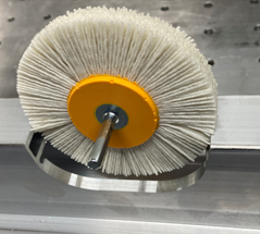
Deburring profiled workpieces
Particularly on edges and contours, undesirable deformations can occur during the manufacturing process of components due to material displacement. These burrs must be removed to eliminate the risk of injury and to ensure an accurate of fit of the components.
Why is it essential to deburr edges and contours?
Burrs occur during the production of a component. Depending on which manufacturing process is used, the burr is more or less pronounced. Especially on edges and contours, these undesirable deformations can occur due to material displacement.
Burrs must be removed because the risk of injuring oneself on sharp cut edges along the contour of a component is very high. Burrs can also reduce the functionality or accuracy of fit of a component.
Deburring can be done manually or with the help of machines. In modern manufacturing processes, deburring is already a scheduled process step that takes place directly after turning, milling, drilling, sintering, etc.. Often even in the same machining centre to keep process times short.
Aluminium crossbar with slight burr residues. Hollow chamber profile, rounded, with burr residue at the milling area.
What are the challenges faced when deburring edges and contours?
The biggest challenge in deburring is to remove all sharp residues from edges and contours while maintaining the shape, size and fit of the component. Other challenges are:
- obtaining the ideal surface finish for the product
- selecting the appropriate deburring process and tool depending on the component (size, structure, material properties and type of burr)
Deburring edges and contours with wheel brushes
In addition to many other deburring processes such as barrel finishing or thermal or chemical deburring, the use of technical brushes has proven successful for removing burrs. Brushing is a mechanical process.
Wheel brushes are used for deburring workpiece edges and contours. They are guided over the cut edge or contour. The rotation of the brush removes the burr from the workpiece.
While steel, sintered metal or aluminium are primarily deburred with abrasive fill material such as ceramic, silicon carbide or aluminium oxide, corrugated steel wire or stainless steel wire is used for cast iron and non-ferrous metals.
The abrasive trim material virtually "grinds off" the burr. When using wire bristles, on the other hand, the burr is (mechanically) struck off. As the size of the burr increases, the wire diameter of the brush is correspondingly larger.

Example of a component-optimised brush, trim material nylon with ceramic corundum.
Products for
Deburring profiled workpieces.

Wheel brushes, crimped wire
Superior
Crimped wheel brush, industrial quality, for use on power drills and high-speed machines.

Wheel brushes, crimped wire
Superior
Wheel brush with crimped wire, industrial quality, for mounting on stationary machines.

Wheel brushes for table-deburring machines, crimped wire
Superior
Wheel brush with crimped wire, industrial quality, for mounting on deburring machines.

Wheel brushes, abrasive filament
Superior
Wheel brush with abrasive bristles, industrial quality, for use on stationary machines.

Wheel brushes, crimped wire
Superior
Multi-row wheel brush with crimped wire, industrial quality, for mounting on stationary machines.

Wheel brushes, crimped wire
Superior
Multi-row wheel brush with crimped wire, industrial quality, for mounting on stationary machines.

Wheel brushes, crimped Osborn wire
Evolution
Crimped wheel brush, high-end quality, for mounting on stationary machines.

UNI-Master® wheel brushes, abrasive filament
Evolution
Wheel brush with abrasive trim, industrial quality, for mounting on deburring machines.

Ringlock Wheel brushes, abrasive filament
Evolution
Ringlock wheel brush, industrial quality, with abrasive silicone carbide trim for attaching to high-speed machines.

Wheel brushes with shank, abrasive filament
Evolution
Ringlock wheel brush, industrial quality, with abrasive silicone carbide trim for attaching to high-speed machines.

UNI-Master® Wheel brushes, Xtreme wire, crimped
Xtreme
Wheel brush with crimped Xtreme wire in high-end quality for use on stationary machines.

Wheel brushes for table-deburring machines, Xtreme wire, crimped
Xtreme
Wheel brushes with crimped Xtreme wire in high-end quality for use on stationary machines.